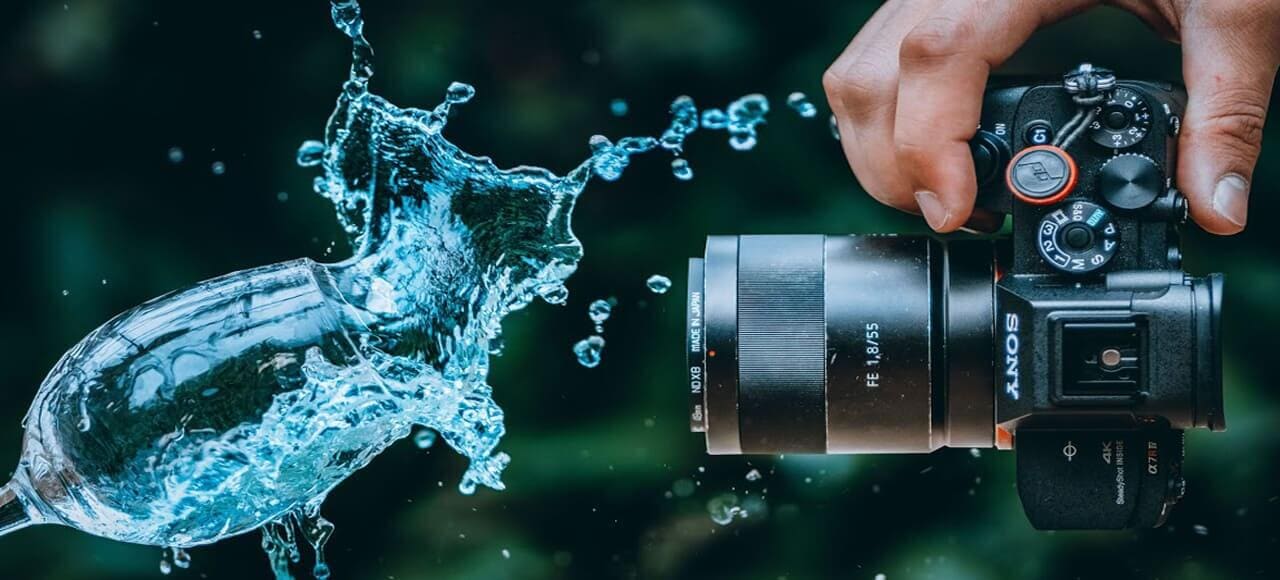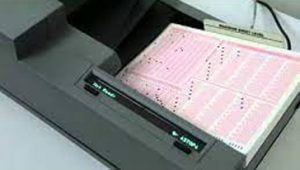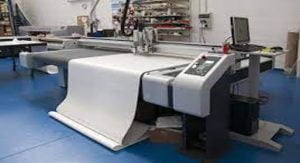Photographers of all skill levels have access to a dizzying variety of various types of cameras now.
Choosing the correct camera body may be challenging, whether you’re looking for a beginner’s point-and-shoot, DSLR, or medium-format camera.
To assist you in making the best decision, this article will describe the best types of cameras for each photography scenario.
12 common types of cameras for photography
Cameras are available in a broad variety of sizes and costs, from the tiniest costly to the largest and most expensive.
Some are perfect for casual usage and vacation, while others are made with business objectives in mind.
While some camera manufacturers make a camera body for each of the above categories, others focus on providing a single kind.
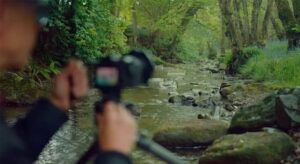
This post will take a quick look at each’s benefits and drawbacks of 12 best types of cameras.
1. DSLR cameras
DSLR (Digital Single Lens Reflex) cameras are well-liked by both pros and amateurs, and even entry-level models may provide excellent results. They are the film-based, digital equivalent of vintage SLR cameras.
This types of cameras are very adaptable instruments because of the wide variety of interchangeable lenses and other available accessories.
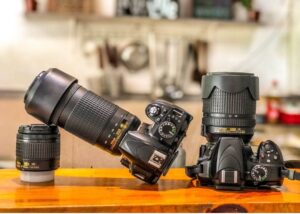
DSLRs are ideal if you’ve just recently begun studying photography since they are often available for less than $500.
A DSLR gives you total control over the camera and the ability to employ semi- and fully automated settings that make photography even simpler, particularly for beginners.
You may purchase anything from a telephoto zoom lens for shooting sports and animals to a portrait prime lens, helpful for producing shots with a shallow depth of focus (DOF) or taking pictures in low light, thanks to the flexibility to change lenses.
A DSLR camera’s optical viewfinder enables perfect focusing and eliminates any delay between what you see and what you capture when you press the shutter. Essentially, you are seeing through clear glass or plastic.
There are two sizes of DSLR sensors: The highest picture quality is achieved with full-frame (36mm x 24mm), whereas APS-C (also known as a crop sensor) is smaller, more compact, and more reasonably priced.
These cameras have bigger sensors than the typical compact camera or smartphone, which is a big benefit since it results in superior image quality, a wider dynamic range, less noise, and the ability to record a crisp subject against a fuzzy background for a more theatrical effect.
DSLRs typically have a more durable camera body and provide superior ergonomics than most compact digital cameras and most mirrorless cameras.
DSLRs are used to capture almost everything, from combat zones to children’s soccer matches.
2. Mirrorless cameras
One of the most common types of camera here is represented by Mirrorless cameras on our list.
Photographers have yearned for something better ever since the invention of cameras, and mirrorless technology seems to be the solution.
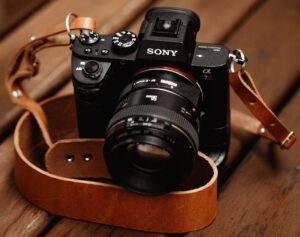
DSLRs were replaced by mirrorless cameras. The removal of the mirror and the installation of an electronic viewfinder in place of the optical viewfinder allowed manufacturers to add a variety of features and benefits.
The technology has advanced to the point recently that DSLRs are now seen as an antiquated camera type.
Many professional and amateur photographers like this types of cameras. Learn more about camera viewfinders here.
Electronic viewfinders (EVF) are now essentially interchangeable with their optical equivalents (OVF), and they also provide additional benefits like live histograms, zebras, and focus magnification.
The EVF is exclusive to this kind of camera and enables the photographer to examine exposure settings in real-time, simplifying and improving photography.
These cameras are often a little bit smaller as well since they lack the mirror mechanism seen in DSLRs.
Other benefits include the ability to shoot a burst of photographs very fast, quiet shooting, and autofocus that can track objects or detect and follow a person’s eye.
They also include adjustable camera settings, various focus modes, high-resolution sensors, wireless picture transmission, HD recording, HDMI video output, faster shutter speed modes (through the electronic shutter), and more, depending on the model.
Since you can simply use an adapter to convert lenses made for DSLR cameras, the limited selection of lenses isn’t much of a drawback.
This is particularly true for manufacturers like Nikon and Canon who have only just debuted mirrorless camera models.
There are three different sensor sizes for mirrorless cameras;
- full-frame
- APS-C
- Micro Four Thirds.
3. Point-and-shoot cameras & compact cameras
Compact cameras, often known as point-and-shoot cameras, are designed to be portable and simple to use, enabling photographers to capture stunning images in a variety of settings.
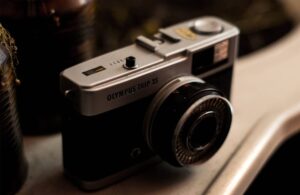
These types of cameras are smaller variants just feature an LCD screen on the rear instead of a viewfinder.
The majority of compact cameras include a lot of automation, but more sophisticated bodies provide users with greater control over elements like ISO and shutter speed.
Compact cameras are practical, but only certain more sophisticated (expensive) models enable you to change settings to take images more artistically.
A typical compact camera has a sensor that is physically considerably smaller than a DSLR or mirrorless camera (1 inch or less in size).
Although you can buy a compact camera with a Micro Four Thirds, APS-C, or even a full-frame sensor if you’re willing to spend much more.
The majority of compacts are portable, somewhat robust, affordable, and offer a respectable amount of battery life.
But you can’t change lenses, photos may be noisy, focusing often won’t be as quick, dynamic range isn’t fantastic, and image quality usually isn’t as good as with a DSLR or a mirrorless camera.
Popular compacts sometimes specialize in one thing, such as providing a great optical zoom range (as opposed to digital zoom) or a tough design that guards against drops, harsh weather conditions, and rain and snow.
To take advantage of both worlds, there will be a great variety of this types of cameras are available. It is customary for photographers to possess both a compact and a bigger mirrorless or DSLR camera.
4. Bridge Cameras
Compact cameras and DSLR/mirrorless cameras are sandwiched by bridge cameras. These types of cameras provide the same degree of ergonomics and control as a DSLR, but without the ability to switch lenses.
Autofocus speed is often slower as well.
The viewfinder is electronic since there isn’t a mirror, giving you benefits like quiet shooting, focus magnification, and a live histogram to assist you to check your exposure.
Typically, this types of cameras feature the same tiny sensors as compact cameras.
Bridge cameras take use of the fact that these tiny sensors make it possible to design lenses that can give a great amount of zoom – significantly more than on a DSLR or mirrorless camera and for a fraction of the price.
The picture quality won’t be as excellent as a DSLR or mirrorless camera.
Most basic and sophisticated capabilities may be obtained on different kinds of digital cameras, but frequently, especially on less expensive models, there is a speed or picture quality trade-off.
With most of the capabilities of other cameras on the market, but without the hassles and costs of changing lenses, bridge cameras are fantastic for streamlining the photography experience.
These kinds of cameras might be the ideal choice if you want the simplicity of point-and-shoot compact cameras but need something with superior ergonomics and battery life.
5. Instant Cameras
In our technologically advanced world, instant cameras can seem a little out of place, but this is just why they are so endearing.
The analog flaw pays homage to photography’s lengthy history. As your picture gradually materializes before your eyes, you get to take home a tangible print that you can touch in your hands.
You won’t have to bother with picture editing software, which makes photography easier and maybe even more pleasurable than with a digital camera.
Despite their vintage appearance, instant cameras often have complete automation, making them relatively simple to operate. Similar to social media filters, the film stock often has a retro aesthetic.
Additionally, because each picture you take with an instant camera will cost money, utilizing one could encourage you to be more thoughtful while creating your images. As with a digital camera, you can’t just shoot away.
Since Polaroid and Instax are the two most widely used camera brands, there aren’t many other kinds of instant cameras to pick from.
The cost of the film might mount up rapidly, although the ordinary instant camera is often inexpensive.
These kinds of cameras are often seen at events and weddings where attendees may snap a picture and have the print in their hands immediately without having to fumble with settings.
6. Film Camera
Shooting with film has numerous advantages over digital photography and this types of cameras can help you a much for that.
The physicality of loading the camera and realizing that your images are being created via a chemical process is quite fulfilling.

Film cameras encourage you to be more careful and thoughtful in your image-making.
In contrast to pixels from a digital camera, taking pictures with a film camera gives you the impression that you are producing something more substantial and important.
Because of the full-frame (35mm) sensor, you can get a beautiful shallow depth of focus (for making a “bokeh” background), and there is a ton of used equipment available, sometimes for very reasonable costs.
The higher dynamic range and unique appearance and feel provided by film cameras mean that many photographers still prefer them. The film compares well to the quality and high resolution of today’s digital cameras.
Although the film is a continuing expense, there is a large selection of film material available. Additionally, scanning negatives and pictures have never been simpler.
A film camera does not provide instant feedback to let you know whether you have exposed or focused it properly, and many older camera models may not even meter the light for you.
See also: best video editing software for all platforms.
You’ll have to compute the parameters for yourself first in addition to dialing them in manually.
In addition to 35mm, used camera stores still offer medium and large format film cameras for sale.
Due to their size, medium and large format cameras often have a shallower depth of focus than 35mm cameras.
An ancient film camera could hold the key to reigniting your enthusiasm for photography if you’ve grown weary of digital camera types’ instant pleasure.
7. Action cameras
Small, portable action cameras may be attached to anything and are always with you. Extreme sports enthusiasts’ ideal equipment, these cameras enable photography in previously inconceivable locations.
Even the most expensive mirrorless or DSLR cameras do not have the level of image stabilization seen in modern models. The ones that aren’t may be placed within a watertight enclosure since many of them are waterproof.
Since everything in your frame will be crisp by default, there is no need to focus since the angle of vision is quite broad.
Although some models feature RAW shooting settings, exposure is automated by default, and colors are bright and saturated.
These cameras lack a viewfinder and, in some cases, even a screen. The majority, however, are smartphone-compatible, enabling you to set up your shot, snap pictures, start and stop recording, and then download and edit the media before sharing it.
Concerning the drawbacks, although having both capabilities, action or adventure cameras are more suited to video than still photography. Batteries often have a limited lifespan, and lenses are fixed.
The greatest option for fully immersive first-person perspective photography is an action camera like the GoPro or one of its counterparts if you require a reasonably priced waterproof camera that can be put anywhere, from your helmet to your motorcycle.
8. Panoramic cameras
Action cameras and 360-degree cameras are both small, portable devices.
They contain two very wide-angle lenses pointing in opposing directions, and video and photographs are stitched together within the camera to provide a full field of vision, enabling you to choose your perspective during the editing process.
They link to your phone similarly to action cameras so you can frame shots, download, and edit video. Typically, they don’t have displays to display your picture on.
These types of cameras are quite specialized in their application and have a small range of options.
They’re still wonderful for vacations and capturing thrilling events, and they’re perfect for recording hyper lapses or anything else that calls for a first-person viewpoint.
Additionally, some models come with special capabilities like the capacity to take “photospheres” and “no drone, no problem” shots using “invisible” selfie sticks.
9. Waterproof cameras and underwater cameras
Next on our list is waterproof cameras which can be very effective for you for making photography underwater.
This types of cameras are available in a wide range of sizes, forms, and prices, from inexpensive fixed-lens cameras that kids may use while on vacation to more expensive interchangeable-lens cameras made specifically for use underwater.
When you’re on vacation, waterproof disposable film cameras may be a lot of fun and provide an inexpensive way to record special moments when you need to put your smartphone someplace dry and secure.
You may want to think about using a waterproof point-and-shoot camera for more serious underwater photography. Due to the added sealing, they are somewhat larger than standard compact cameras.
The majority of underwater camera cameras, whether they come with casings or not, can be submerged to a maximum depth of 15 to 30 meters.
There are other underwater cameras, some of which include a lighting system, made expressly for scuba divers to carry about when diving to photograph marine life and shipwrecks.
Today, the majority of action cameras are waterproof up to a depth of around 10 meters, and those that aren’t may be placed within a watertight shell.
10. Medium Format Cameras
The greatest picture quality is available from all of the alternatives on our list when using medium format cameras, whether they are film or digital.
The cost of this types of cameras has decreased significantly over the last two years, and the least costly models now cost around the same as the most expensive mirrorless and DSLR models.
Tens of thousands of dollars may be spent on high-end models, and medium-format camera lenses can be pricey as well.
Medium format cameras are a popular option for professional photographers because they provide incredible picture clarity and resolution even though shooting is often slower, has worse focusing performance, and has lower burst rates. Superior dynamic range and more accurate color reproduction are two additional benefits.
Medium format cameras are often the best option for professional photographers to shoot images for a billboard campaign or magazine cover.
11. Smartphone cameras
Over the last ten years, smartphone cameras have significantly reduced the sales of other kinds of digital cameras, and the technology continues improving.
Today, practically everyone carries a powerful digital camera with them at all times.
Numerous lenses are now included in smartphones in addition to front-facing cameras. These lenses can now simulate the fuzzy background that was previously only possible with much bigger cameras thanks to AI, and new models also come with capabilities like face and even eye focusing and subject tracking as the standard camera.
Smartphones also include a night mode that cleverly combines numerous exposures in real-time to significantly brighten dimly illuminated areas.
Smartphones’ small sensors result in low dynamic range and grainy photos as the light level drops, however, this is easily offset by the convenience of always having a powerful gadget at hand.
The ability to edit, share, and back up a shot as soon as it is taken is a significant benefit, and many camera applications give the option to alter manual settings as well as image size and format.
To do this, many professionals employ cloud-based editing tools like Adobe Lightroom.
With the most recent handsets capable of taking pictures that rival specialized cameras, iPhone photography is the genre of photography that is expanding the quickest in the globe.
However, capturing pictures on your phone isn’t a very fun experience, and the various types of cameras in this guide are still widely used due to drawbacks including short battery life, a lack of a viewfinder, restricted RAW capabilities, and awkward ergonomics.
12. Rangefinder cameras
These cameras, which were popular in the 1950s because of their compactness, durability, and affordability, focus on utilizing a dual-image range-finding system.
In essence, you rotate a ring on the lens to line up two pictures that are superimposed; when they do, your picture will be in focus.
With a rangefinder, you gaze through a “window” at the top of the camera, as opposed to an SLR where you view through the lens. It takes some getting accustomed to it, but some photographers like this experience.
The majority of rangefinders are available used; Leica is one of the few manufacturers currently selling them new.
Last Words
The variety of cameras on the market might be a little perplexing, but happily, there is something to suit every photography style and budget.
Please include any camera types you use in the comments section if we’ve forgotten any.
I hope you found this article’s material to be useful. As usual, don’t hesitate to ask any questions or share your opinion.
Recommended articles:
Stylus pen | types, advantages, disadvantages and purpose of stylus pen
9 best types of monitors and 3 main categories of monitors
Best 9 types of printer | Which is best for you?
Best 7 Types of Scanners with details
Different computer peripherals with details of them
Best 3 types of projectors, use, advantages and disadvantages in details
Best 11 types of mouse with description | Which mouse is best?

